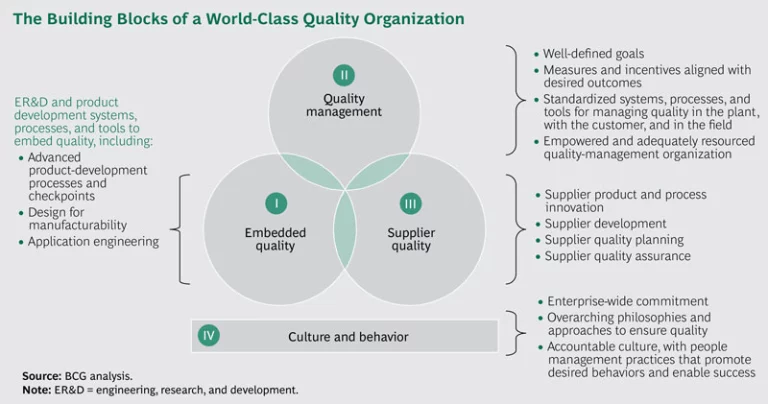If automotive manufacturers think that they’ve achieved pinnacles of quality just because it’s rare to see broken-down cars by the roadside these days, they need to think again.
Hardly a month goes by without the announcement of yet another automotive recall affecting hundreds of thousands of vehicles. Air bags, seat belts, electrical wiring—the defective systems and subsystems that trigger the recalls vary widely, but they are all symptoms of a serious problem that pervades the automotive supply chain: widespread failures of quality assurance.
The numbers tell the story. Among the major global OEMs alone, total recalls have increased in every decade of the last 30 or more years, rising from around 700 recall campaigns that affected roughly 700,000 units in the 1980s to more than 1,300 such campaigns that affected 13 million vehicles in the first decade of this century. Even Toyota, a company long noted for quality and reliability, has seen its recall rates climbing steeply. The recalls have not only inflicted significant reputational damage on the OEMs and their suppliers, but they have also exposed automotive companies to billions of dollars in liability.
In today’s high-pressure environment, with record numbers of product launches, increasingly demanding customers, and constant scrutiny through social media, OEMs and suppliers can no longer afford to wait and react to the next quality problem. Now is the time for them to get ahead of these problems and transform quality into a source of competitive advantage. If cost pressures don’t spur them to action, regulators such as the US National Highway Traffic Safety Administration—itself stung by public criticism, given the numbers of recalls—certainly will.
New Technologies Have Created New Risks
The fundamental challenge is that the cars themselves—and how they are made—are immeasurably more complicated than those of 60 years ago. The automotive landscape is being transformed by new and exciting power-train, active-safety, and connectivity technologies that are fundamentally changing the vehicle experience. But this has created a problem for OEMs and suppliers, which must ensure the quality of each component.
Complicating their task is the fact that as technologies evolve, the rules governing OEM-supplier interactions are changing. New technologies have brought about the emergence of new players ranging from upstart OEMs to more traditional consumer-electronics and battery manufacturers—many of which have become important suppliers overnight.
Every one of these newcomers is in the early stages of understanding the demands that govern OEM-supplier interactions. The very basis of competition is also changing rapidly and profoundly.
In some sectors, OEMs are increasingly looking to suppliers for innovation. In other areas, OEMs are doing more in-house engineering and development, and in the process, they are blurring the supply chain’s historical boundaries.
Furthermore, in many component sectors, OEMs are unbundling traditional systems and sourcing more at the component level. Although this practice has generated significant cost savings, it has also greatly increased supply chain complexity and risk and has put even bigger demands on the quality infrastructure.
These changes carry significant risks. The costs of substandard quality, already high, are rising fast. They include the expense of field actions, recall campaigns, and warranty claims, as well as the costs of defective products that fail inspection and require rework.
Other costs include expenditures by OEMs and suppliers—everything from charge-backs for quality defects to the costs associated with lost manufacturing capacity and expediting of replacement parts. And of course, there is the corrosive intangible damage to a company’s brand reputation.
Adjustments That OEMs and Suppliers Must Make
Against this backdrop, OEMs and suppliers need to significantly raise their game in quality. They must take strong, proactive steps to improve their quality organizations and meet increasing demands from regulators, customers, and one another.
Over the past few years, we have worked with leading automotive companies to assess the maturity of their quality organizations, define gaps in best practices, and put in place programs designed to close gaps and transform the organization. In the course of these experiences, we have found that every world-class automotive-quality organization relies on discrete building blocks. (See the exhibit.)
We have also observed a wide range in the maturity of automotive companies’ quality organizations. Some have achieved best-in-class quality against which other organizations measure themselves, while many others can claim no more than that their quality is acceptable. In the exemplary companies, quality is much more than just a well-defined function: it is a way of working that is integral to the company’s culture. One glimpse of what that means: in best-in-class companies, every employee feels responsible for quality, and measures and incentives are in place to reinforce this. By contrast, in companies with basic quality approaches, quality has the attention but not the deep commitment of top management. Quality metrics are in place, but they are typically applied only to staff within the quality organization.
These, then, are the critical questions: Where—between basic maturity and best-in-class—is your company’s starting point? How do you drive the desired step-change improvements in quality? (See “Must-Ask Questions.”)
MUST-ASK QUESTIONS
As companies reflect on their quality infrastructures, we urge management to ask a few questions focused on critical considerations:
Embedded Quality. To what degree does your company set up each new-vehicle program for success? Does each program have a well-defined product-development process that is cross-functional in nature in order to ensure aspects such as design for manufacturability? To what extent does each program employ standardization and platform sharing to minimize complexity? Are late-stage design changes the norm or the exception?
Quality Management. How well-defined is your quality infrastructure? Are processes clear and tools well understood? Are process controls, visual management, and standard work processes in place? Are best practices disseminated across the network? Is compliance with best practices enforced through well-defined measures and incentives?
Supplier Quality. To what degree do the organization’s sourcing policies, supplier-development processes, and governance ensure and reinforce quality principles? Do suppliers and customers collaborate on the production part-approval process to manage quality in a direct-sourcing environment? Are suppliers and customers resilient enough to intervene at the first sign of quality slippage and to adjust processes or specifications as needed?
Culture and Behavior. To what degree is the company’s overarching quality philosophy built into the organization’s culture and enforced through incentives and sanctions? Is the quality organization properly resourced? Does it have the stature and decision-making rights necessary to drive the desired behavior throughout the supply chain, including the authority to call for a pause in product development or production if conditions warrant? Does only good news travel up, or do employees feel comfortable calling attention to deviations in quality, noncompliance with standards, and lapses in quality management?
By systematically assessing maturity along each of these dimensions, companies can identify gaps in their quality operating models. The gaps can then be prioritized by size and potential impact, and the companies can define paths to strengthen required capabilities.
After you have assessed the starting point, the stage will be set for driving improvement. The foundation of this improvement requires the right people who have the time and capabilities to tactically move the organization in the new direction. By aligning these people with the critical initiatives derived from the starting point and the target future state, companies can significantly improve their chances of attaining higher quality levels.
Six Imperatives for Best-in-Class Automotive Quality
Automotive customers have never before been more sensitive to quality, and the penalties for lapses in quality have never been more severe, immediate, or long-lasting. As a senior automotive leader, you must understand what’s at stake for your company (indeed, for the whole industry) and realize what subpar quality implies for your future. Once you’ve set the stage for change, you should consider these six quality-related imperatives that can help accelerate your company’s journey:
- Quality must have a seat at the table for major product-development and production decisions. The quality organization must be fully empowered to stop a program if quality is in question. For example, during the product development process, leaders from the quality teams should be active participants in all milestone reviews, assessing product quality and putting a hold on progression through the product development gates until identified gaps are resolved.
- A well-established engineering-design library must be at the center of product development. It should guide decisions regarding the use and reuse of standard parts and should enforce rigorous validation discipline for new-part introductions. The added design scrutiny that these processes require will reduce the likelihood of introducing new parts that fall short of quality expectations.
- The quality organization must have sufficient resources, including those for oversight of supplier quality. For example, each OEM-supplier quality engineer should be responsible for no more than ten supplier locations. Furthermore, senior leadership must support the quality organization through structure, compensation, and job titles commensurate with the organization’s importance.
- Clear quality KPIs and incentives throughout the organization—even to the level of the individual—must be standard for everyone, not just people with the word “quality” in their job titles. At a minimum, those metrics should be tied to annual performance reviews and compensation for senior leadership.
- Manufacturing must be involved in the early stages of the engineering and product development process and should promote standardization of processes and equipment to ensure repeatability.
- A well-defined plan should be in place to incorporate the best aspects of Industry 4.0 (the next wave of intelligent industrial automation) to automate critical work steps and provide greater traceability at the component and system level for safety-critical parts.
It is not enough simply to list quality as a core value. Companies must live that value, investing in the organization, processes, and tools needed to make quality a true source of advantage and core to the company’s culture.
How and when can companies do that? Automotive executives must not wait for the next analyst meeting to try to explain the inevitable questions about recalls and general quality glitches. They’ve got to get ahead of the problems, proactively identifying and putting in place the initiatives that will improve and consistently uphold top quality at every level of the process and product.
It bears repeating: the quality bar is only going to get higher. The automotive companies that struggle to keep pace will find themselves significantly—perhaps permanently—disadvantaged. Yet the rewards for high and improving quality have never been greater. The automotive companies that win the race to better quality today will be the industry leaders and benchmarks for years to come.
In which category will your company be five or six years from now?






